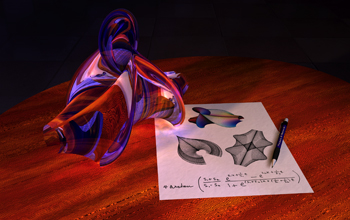Multimedia Gallery
"Kuen's Surface: A Meditation on Euclid, Lobachevsky and Quantum Fields"
"Kuen's Surface: A Meditation on Euclid, Lobachevsky and Quantum Fields," by Dick Palais, University of California, Irvine, and digital artist Luc Benard.
Sketch a line and then draw a point off it. How many lines parallel to the first line can you draw through that point? The Greek mathematician Euclid said just one, but for more than 2,000 years after his death, mathematicians have struggled to prove he was right based on his other geometric rules. Then the 19th century Russian mathematician Nikolai Lobachevsky showed that you couldn't: In some circumstances, you can sketch an infinite number of lines through that point and not violate any of Euclid's other axioms. Palais, a mathematician, and Benard wanted to convey the history of Lobachevsky's solution to this mathematical puzzle with their illustration.
In this illustration, a sheet of paper shows sketches of one of these surfaces, called Kuen's surface, and the expression, called a soliton, which describes it. "We wanted to talk about these equations in a way that non-mathematicians could understand," Palais says. "So we took a symbolic approach: The surface itself stands as a symbol for that equation." [Note: Work on the software (3D-XplorMath) used to create the Kuen Surface on which this visualization is based was supported by a National Science Foundation (NSF) grant to UC-Irvine, with Richard Palais as principal investigator (DUE 05-14781).]
This image won first place in the Illustration category of the 2009 International Science & Engineering Visualization Challenge (SciVis) competition, sponsored by NSF and the journal Science. The competition is held each year to celebrate the grand tradition of science visualization and to encourage its continued growth. The spirit of the competition is to communicate science, engineering and technology for education and journalistic purposes. To learn more about the competition and view all the winning entries, see the NSF SciVis Special Report. (Date of Image: Spring 2009)
Credit: ©Luc Benard, University of California, Irvine
See other images like this on your iPhone or iPad download NSF Science Zone on the Apple App Store.
Special Restrictions: This image may be used freely for noncommercial/nonprofit, educational and research purposes only. For any commercial purpose, contact the copyright holder, Luc Benard, via email at ludev2@gmail.com, or by mail: Luc Benard, 4991 Paisley app 6, Saint-Leonard Qc H1S 1T6, for permission.
Images and other media in the National Science Foundation Multimedia Gallery are available for use in print and electronic material by NSF employees, members of the media, university staff, teachers and the general public. All media in the gallery are intended for personal, educational and nonprofit/non-commercial use only.
Images credited to the National Science Foundation, a federal agency, are in the public domain. The images were created by employees of the United States Government as part of their official duties or prepared by contractors as "works for hire" for NSF. You may freely use NSF-credited images and, at your discretion, credit NSF with a "Courtesy: National Science Foundation" notation.
Additional information about general usage can be found in Conditions.
Also Available:
Download the high-resolution JPG version of the image. (3.1 MB)
Use your mouse to right-click (Mac users may need to Ctrl-click) the link above and choose the option that will save the file or target to your computer.

